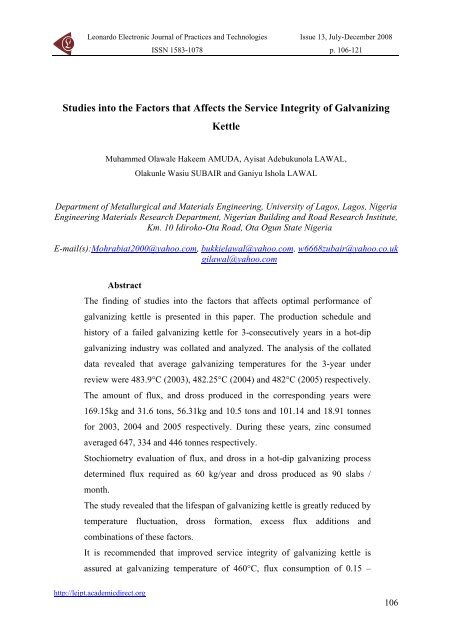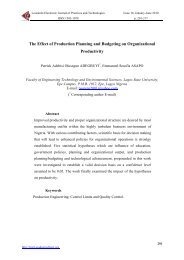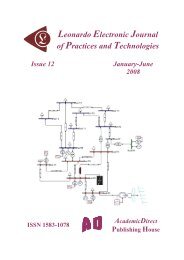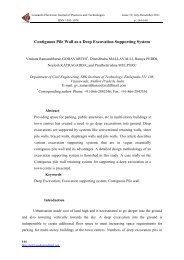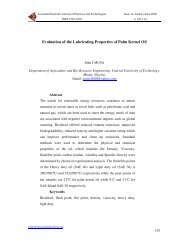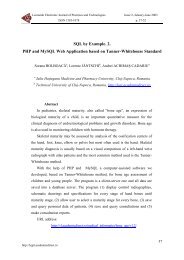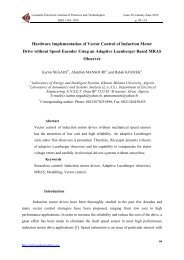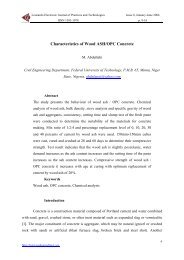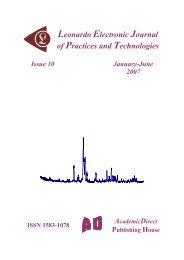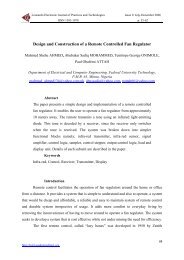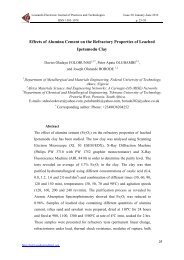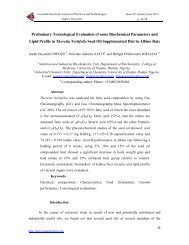p. 106-121 - Leonardo Electronic Journal of Practices and ...
p. 106-121 - Leonardo Electronic Journal of Practices and ...
p. 106-121 - Leonardo Electronic Journal of Practices and ...
You also want an ePaper? Increase the reach of your titles
YUMPU automatically turns print PDFs into web optimized ePapers that Google loves.
<strong>Leonardo</strong> <strong>Electronic</strong> <strong>Journal</strong> <strong>of</strong> <strong>Practices</strong> <strong>and</strong> Technologies<br />
ISSN 1583-1078<br />
Issue 13, July-December 2008<br />
p. <strong>106</strong>-<strong>121</strong><br />
Studies into the Factors that Affects the Service Integrity <strong>of</strong> Galvanizing<br />
Kettle<br />
Muhammed Olawale Hakeem AMUDA, Ayisat Adebukunola LAWAL,<br />
Olakunle Wasiu SUBAIR <strong>and</strong> Ganiyu Ishola LAWAL<br />
Department <strong>of</strong> Metallurgical <strong>and</strong> Materials Engineering, University <strong>of</strong> Lagos, Lagos, Nigeria<br />
Engineering Materials Research Department, Nigerian Building <strong>and</strong> Road Research Institute,<br />
Km. 10 Idiroko-Ota Road, Ota Ogun State Nigeria<br />
E-mail(s):Mohrabiat2000@yahoo.com, bukkielawal@yahoo.com, w6668zubair@yahoo.co.uk<br />
gilawal@yahoo.com<br />
Abstract<br />
The finding <strong>of</strong> studies into the factors that affects optimal performance <strong>of</strong><br />
galvanizing kettle is presented in this paper. The production schedule <strong>and</strong><br />
history <strong>of</strong> a failed galvanizing kettle for 3-consecutively years in a hot-dip<br />
galvanizing industry was collated <strong>and</strong> analyzed. The analysis <strong>of</strong> the collated<br />
data revealed that average galvanizing temperatures for the 3-year under<br />
review were 483.9°C (2003), 482.25°C (2004) <strong>and</strong> 482°C (2005) respectively.<br />
The amount <strong>of</strong> flux, <strong>and</strong> dross produced in the corresponding years were<br />
169.15kg <strong>and</strong> 31.6 tons, 56.31kg <strong>and</strong> 10.5 tons <strong>and</strong> 101.14 <strong>and</strong> 18.91 tonnes<br />
for 2003, 2004 <strong>and</strong> 2005 respectively. During these years, zinc consumed<br />
averaged 647, 334 <strong>and</strong> 446 tonnes respectively.<br />
Stochiometry evaluation <strong>of</strong> flux, <strong>and</strong> dross in a hot-dip galvanizing process<br />
determined flux required as 60 kg/year <strong>and</strong> dross produced as 90 slabs /<br />
month.<br />
The study revealed that the lifespan <strong>of</strong> galvanizing kettle is greatly reduced by<br />
temperature fluctuation, dross formation, excess flux additions <strong>and</strong><br />
combinations <strong>of</strong> these factors.<br />
It is recommended that improved service integrity <strong>of</strong> galvanizing kettle is<br />
assured at galvanizing temperature <strong>of</strong> 460°C, flux consumption <strong>of</strong> 0.15 –<br />
http://lejpt.academicdirect.org<br />
<strong>106</strong>
107<br />
Studies into the Factors that Affects the Service Integrity <strong>of</strong> Galvanizing Kettle<br />
Muhammed O. H. AMUDA, Ayisat A. LAWAL, Olakunle W.SUBAIR <strong>and</strong> Ganiyu I. LAWAL<br />
0.20kg daily <strong>and</strong> constant removal <strong>of</strong> dross at 3-5 slabs per day. This reduces<br />
the formation <strong>of</strong> skim lines, which leads to pits on the walls <strong>of</strong> the kettle.<br />
Keywords<br />
Service integrity; galvanizing temeperature, Flux; Dross; Galvanizing kettle<br />
Introduction<br />
Ferrous materials find application in transportation, telecommunication, health<br />
services, civil <strong>and</strong> building construction, manufacturing <strong>and</strong> allied industries [1-3]. They are<br />
particularly prominent as structural element <strong>and</strong> ro<strong>of</strong>ing material in the built environment<br />
because they are relatively cheaper <strong>and</strong> are flexible in manifesting different structural<br />
properties by the modification <strong>of</strong> their structure through any <strong>of</strong> the various structural<br />
transformation techniques [4]. However, ferrous materials typified by steel have one major<br />
draw back. Steel greatly depreciates when exposed to unfriendly environment [5]. The<br />
consequences <strong>of</strong> such depreciation may involve loss <strong>of</strong> active production time, accident,<br />
economic loss <strong>and</strong> at times may be exceedingly fatal. This is more important in situations<br />
where steel is used as load carrying element; bridges, mast <strong>and</strong> towers, rebar reinforcement,<br />
corrugated ro<strong>of</strong>ing sheet [6]. Corrosion in these systems is better prevented from setting in<br />
than making effort at stopping it once it is initiated. There are two principal methods <strong>of</strong><br />
preventing corrosion. In one <strong>of</strong> the methods, the metallic surface is insulated from the<br />
corrosive medium by some form <strong>of</strong> protective coating. Some <strong>of</strong> these coatings are various<br />
types <strong>of</strong> paints <strong>and</strong> vanishes, metallic films having good corrosion resistance <strong>and</strong> artificially<br />
thickened oxide films. In the other method, though quite expensive, metal/alloy which has<br />
inherent corrosion resistance is employed [7]. The option <strong>of</strong> using protective coatings is <strong>of</strong>ten<br />
adopted. The most widely used metallic coatings are electroplating <strong>and</strong> dipping. For instance,<br />
in the built environment, protection <strong>of</strong> plumbing, transport systems <strong>and</strong> corrugated ro<strong>of</strong>ing<br />
sheet made <strong>of</strong> ferrous material is effected through a process known as hot-dip galvanizing. In<br />
the process, iron <strong>and</strong> steel is coated with a thin zinc layer at a temperature <strong>of</strong> about 460°C in a<br />
molten bath <strong>of</strong> zinc known as galvanizing kettle. Galvanizing as a means <strong>of</strong> corrosion control<br />
is used majorly in chemical processes, utilities, pulp <strong>and</strong> paper, automobile <strong>and</strong> transportation<br />
industries [8].
<strong>Leonardo</strong> <strong>Electronic</strong> <strong>Journal</strong> <strong>of</strong> <strong>Practices</strong> <strong>and</strong> Technologies<br />
ISSN 1583-1078<br />
Issue 13, July-December 2008<br />
p. <strong>106</strong>-<strong>121</strong><br />
The critical unit in the galvanizing process is the galvanizing kettle (the zinc pot). This<br />
unit made <strong>of</strong> low-carbon low silicon steel is rectangular in framework <strong>and</strong> is where the actual<br />
galvanizing is accomplished. The chemical reaction <strong>of</strong> the galvanizing process takes place in<br />
the kettle. After several cycles <strong>of</strong> operation, the inside <strong>of</strong> the kettle is attacked by molten flux,<br />
zinc <strong>and</strong> dross. The attack is aggravated by temperature fluctuations. This leads to erosion <strong>and</strong><br />
builds up <strong>of</strong> deposit <strong>and</strong> ultimately cracks in the kettle [9]. The success <strong>of</strong> the galvanizing<br />
process is highly affected by the integrity <strong>of</strong> the galvanizing kettle. Therefore, there is<br />
motivation to investigate the loss in integrity <strong>of</strong> the galvanizing kettle as a result <strong>of</strong> the<br />
interaction <strong>of</strong> these factors with a view to determining optimum conditions <strong>of</strong> flux, dross <strong>and</strong><br />
production temperature necessary for enhancing the lifespan <strong>of</strong> a typical galvanizing kettle.<br />
The present work discussed the findings from studies into the effect <strong>of</strong> factors such as<br />
amounts <strong>of</strong> flux, dross <strong>and</strong> production temperature on the service integrity <strong>of</strong> galvanizing<br />
kettle. The object <strong>of</strong> the studies is to evaluate means <strong>of</strong> improving the lifespan <strong>of</strong> the<br />
galvanizing kettle. The investigation involved studying the effect <strong>of</strong> temperature on localized<br />
wear <strong>of</strong> the kettle <strong>and</strong> that <strong>of</strong> intermetallic dross on the capacity <strong>of</strong> the galvanizing kettle.<br />
Besides, the contribution <strong>of</strong> flux to intermetallic dross is reported.<br />
Material <strong>and</strong> Method<br />
Sourcing <strong>of</strong> Material<br />
Production data were collected from Galvanizing Industries Limited, Oba Akran<br />
Road, Ikeja Industrial Estate, Nigeria. The data collected spanned three year production<br />
schedule. Other materials are analar grade saturated solution <strong>of</strong> sodium carbonate, 6M nitric<br />
acid, 0.1M silver nitrate, sodium hydroxide.<br />
The constituent components <strong>of</strong> the galvanizing process are the zinc pot (galvanizing<br />
kettle), the flux box, the zinc box, pyrometer, inner guide <strong>and</strong> chemical. The critical unit in<br />
the galvanizing process is the zinc pot. A cross-sectional representation <strong>of</strong> the galvanizing<br />
kettle is given in Figure 1.<br />
108
109<br />
Studies into the Factors that Affects the Service Integrity <strong>of</strong> Galvanizing Kettle<br />
Muhammed O. H. AMUDA, Ayisat A. LAWAL, Olakunle W.SUBAIR <strong>and</strong> Ganiyu I. LAWAL<br />
Figure 1. Sectional view <strong>of</strong> the zinc pot [10]<br />
Table1. Dimensions <strong>of</strong> important parts<br />
A. 6 ¾ “ 171mm Depth <strong>of</strong> Coating rolls<br />
B. 9” 229mm Depth <strong>of</strong> Zinc layer<br />
C. ½“ 13mm Depth <strong>of</strong> Dross layer<br />
D. 23 1 /8” 587mm Depth <strong>of</strong> Lead layer<br />
E. 5 ½ “ 139mm Depth from edge to Coating rolls<br />
F. 7” 178mm Depth <strong>of</strong> Flux layer<br />
G. 26 7 /8” 683mm Depth <strong>of</strong> Lead layer<br />
Each component <strong>of</strong> the galvanizing process is discussed in detail.<br />
The zinc pot is a low carbon, low silicon rimmed steel constructed via electric arc<br />
welding using compatible low carbon low silicon electrode. It is rectangular in shape <strong>of</strong><br />
dimension 2400mm x 1450mm x 950mm <strong>and</strong> 32mm thick. It is used for holding the various<br />
compartments as well as the chemicals for heating during galvanizing operation.<br />
The Flux Box is made <strong>of</strong> stainless steel or low carbon low silicon steel with firebrick<br />
lining inside to protect it from chemical attack. The flux box is used to inject flux during the<br />
galvanizing operation.
<strong>Leonardo</strong> <strong>Electronic</strong> <strong>Journal</strong> <strong>of</strong> <strong>Practices</strong> <strong>and</strong> Technologies<br />
ISSN 1583-1078<br />
Issue 13, July-December 2008<br />
p. <strong>106</strong>-<strong>121</strong><br />
The Zinc Box is <strong>of</strong> the same composition as the galvanizing kettle, it is electric arc<br />
constructed, rectangular in shape <strong>and</strong> 32mm thick.<br />
The Pyrometer<br />
A chrome-alumel thermocouple with compensating wire <strong>of</strong> copper/constantan system<br />
was used as a temperature measuring device.<br />
The inner Guide is also made <strong>of</strong> the same steel as that <strong>of</strong> the flux box <strong>and</strong> galvanizing<br />
kettle. It has the following specifications-thickness <strong>of</strong> steel plate-25mm, width <strong>of</strong> steel plate-<br />
80mm, number <strong>of</strong> steel plate-15 pieces <strong>of</strong> both the upper <strong>and</strong> lower guide. It is curved <strong>and</strong><br />
thus allows the easy passage <strong>of</strong> the black sheet during the galvanizing process.<br />
Method<br />
Collection <strong>of</strong> Failed Galvanizing Kettle Data<br />
A dis-used galvanizing kettle was picked from the galvanizing industry. The<br />
production data associated with the dis-used galvanizing kettle were collated, tabulated <strong>and</strong><br />
analyzed (Tables 2-4).<br />
Table 2.Zinc consumption, dross output <strong>and</strong> galvanizing temperature for 2003<br />
MONTH ZINC (SLABS) DROSS (SLABS) TEMPERATURE ( ° C)<br />
Jan 3382 198 480<br />
Feb 3427 194 468<br />
Mar 2096 97 479<br />
Apr 3669 262 477<br />
May 902 68 483<br />
June 1907 126 489<br />
July 2980 279 491<br />
Aug 2791 139 492<br />
Sept 2982 190 491<br />
Oct 1780 111 489<br />
Nov - - -<br />
Dec - - -<br />
Total 25916 1664 4839<br />
A zinc slab = 25kg<br />
A dross slab = 19kg<br />
Zinc consumption = 647,900kg<br />
Dross output = 31,616kg<br />
Average temperature=483.9 ° C<br />
110
111<br />
Studies into the Factors that Affects the Service Integrity <strong>of</strong> Galvanizing Kettle<br />
Muhammed O. H. AMUDA, Ayisat A. LAWAL, Olakunle W.SUBAIR <strong>and</strong> Ganiyu I. LAWAL<br />
Table 3.Zinc consumption, dross output <strong>and</strong> galvanizing temperature for 2004<br />
MONTH ZINC (SLABS) DROSS (SLABS) TEMPERATURE ( ° C)<br />
Jan 2758 194 472<br />
Feb 1574 60 473<br />
Mar 1491 53 476<br />
Apr 961 41 493<br />
May 1790 68 490<br />
June 1696 10 485<br />
July 937 63 494<br />
Aug 2148 65 475<br />
Sept - - -<br />
Oct - - -<br />
Nov - - -<br />
Dec - - -<br />
Total 13355 554 3858<br />
A zinc slab = 25kg<br />
A dross slab = 19kg<br />
Zinc consumption = 333,876kg<br />
Dross output = 10,526kg<br />
Average temperature = 482.25 ° C<br />
Table 4. Zinc consumption, dross output <strong>and</strong> galvanizing temperature 2005<br />
MONTH ZINC (SLABS) DROSS (SLABS) TEMPERATURE ( 0 C)<br />
Jan 2688 190 483<br />
Feb 3088 186 482<br />
Mar 2462 148 490<br />
Apr 1392 57 485<br />
May 1706 67 482<br />
June <strong>106</strong>6 46 476<br />
July 1175 93 475<br />
Aug 2256 111 475<br />
Sept - - -<br />
Oct 431 8 490<br />
Nov 1500 89 489<br />
Dec - - -<br />
Total 17824 995 4825<br />
A zinc slab = 25kg<br />
A dross slab = 19kg<br />
Zinc consumption = 445,600kg<br />
Dross output = 18,905kg<br />
Average temperature = 482 ° C
<strong>Leonardo</strong> <strong>Electronic</strong> <strong>Journal</strong> <strong>of</strong> <strong>Practices</strong> <strong>and</strong> Technologies<br />
ISSN 1583-1078<br />
Issue 13, July-December 2008<br />
p. <strong>106</strong>-<strong>121</strong><br />
The amount <strong>of</strong> flux-ammonium chloride-dispersed in a fixed quantity <strong>of</strong> intermetallic<br />
dross was determined through wet analysis. The analysis involve identification <strong>of</strong> both<br />
ammonium <strong>and</strong> chloride ions to confirm the presence <strong>of</strong> flux in the dross <strong>and</strong> then using<br />
simple stoichiometry equation to determine amount <strong>of</strong> flux dispersed in a known quantity <strong>of</strong><br />
dross.<br />
Identification <strong>of</strong> Ammonium, Chloride Ions <strong>and</strong> Calculation <strong>of</strong> Amount <strong>of</strong><br />
Flux in Dross<br />
1g <strong>of</strong> the dross sample was placed in 25ml beaker. 2ml 6M sodium hydroxide solution<br />
was added. The mixture was covered with a watch glass stucked with a piece <strong>of</strong> red litmus<br />
paper underneath it. The content was warmed gently. The red colour <strong>of</strong> the litmus paper<br />
changed to blue, thus confirming the presence <strong>of</strong> ammonium ions.<br />
2g <strong>of</strong> dross sample was weighed <strong>and</strong> placed in 25ml beaker. 10ml saturated solution <strong>of</strong><br />
sodium carbonate was added <strong>and</strong> warmed until the sample dissolved. 3 drops <strong>of</strong> the warmed<br />
solution was added to 10ml <strong>of</strong> water <strong>and</strong> acidified with nitric acid. 2ml <strong>of</strong> 0.1M silver nitrate<br />
solution was added. A white precipitate <strong>of</strong> silver chloride formed immediately. This confirms<br />
the presence <strong>of</strong> chloride ions.<br />
AgNO + Cl ⎯⎯→<br />
AgCl<br />
+ NO<br />
−<br />
−<br />
3 ( S ) 3 ( aq)<br />
1g <strong>of</strong> dross sample was dissolved in 6M sodium hydroxide in a 100ml beaker. The mixture<br />
was agitated <strong>and</strong> allowed to settle. Ammonia gas was evolved. The volume <strong>of</strong> hydrochloric<br />
acid produced was determined through titration with sodium hydroxide. The titre value <strong>of</strong> Hcl<br />
was 59.9ml. Therefore, the volume <strong>of</strong> sodium hydroxide consumed by ammonium chloride to<br />
liberate ammonia (NH3) gas is (60-59.9) ml = 0.1ml<br />
Results <strong>and</strong> Analysis <strong>of</strong> Result<br />
Analysis <strong>of</strong> Result<br />
The stoichiometry equation for the reaction is<br />
NaOH +<br />
+ NH 4Cl ⎯⎯→<br />
NH 3 + HCl<br />
( g ) ( aq)<br />
H 2O<br />
↑<br />
( L)<br />
1 mole NH4CL requires 1 mole NaOH to liberate 1 mole NH3(g).<br />
112
113<br />
Studies into the Factors that Affects the Service Integrity <strong>of</strong> Galvanizing Kettle<br />
Muhammed O. H. AMUDA, Ayisat A. LAWAL, Olakunle W.SUBAIR <strong>and</strong> Ganiyu I. LAWAL<br />
Applying Avogadros law, this implies that<br />
NH 4<br />
+ −<br />
1 volume CL requires 1 volume NaOH<br />
+ −<br />
Thus 0.1ml CL consumed 0.1M NaOH<br />
NH 4<br />
+ −<br />
But 1 mole CL = 53.5g<br />
NH 4<br />
Recall that 1 slab <strong>of</strong> dross = 19kg (19000g)<br />
If 1g <strong>of</strong> dross ≡ 0.000535 kg <strong>of</strong><br />
+ −<br />
NH 4 CL<br />
then 19000g <strong>of</strong> dross ≡ 0.10165kg <strong>of</strong><br />
+ −<br />
NH 4 CL<br />
For year 2003, the average dross output was 31,616kg, therefore, contribution <strong>of</strong> flux<br />
to dross is given as<br />
0.<br />
10165x31616<br />
31,<br />
616kg(<br />
dross)<br />
≡<br />
19<br />
+ −<br />
=169.15 kg <strong>of</strong> NH 4 CL (flux)<br />
+ −<br />
+ −<br />
At 25kg/bag <strong>of</strong> CL ; this implies that about 6 bags <strong>of</strong> CL is lost to dross in<br />
NH 4<br />
the production year 2003.<br />
For year 2004, the dross output was 10,526kg, therefore contribution <strong>of</strong> flux to dross<br />
0. 10165x10526<br />
10,526kg (dross) ≡<br />
19<br />
NH 4<br />
=56.31kg <strong>of</strong><br />
+ −<br />
NH 4 CL<br />
NH 4<br />
+ −<br />
+ −<br />
At 25kg/bag <strong>of</strong> CL in the production year 2004; about 2 bags <strong>of</strong> CL was<br />
lost to dross formation.<br />
This low volume <strong>of</strong> flux in dross was apparently because there was no production in<br />
2004 for four months (September - December) (Table 2).<br />
For 2005:<br />
Dross output=18,905kg<br />
Contribution <strong>of</strong> flux to dross<br />
0. 10165x18905<br />
18,905 kg (dross) ≡<br />
19<br />
= 101.14kg <strong>of</strong><br />
+ −<br />
NH 4 CL<br />
This translates to about 4 bags <strong>of</strong> flux at 25kg/bag.<br />
NH 4
<strong>Leonardo</strong> <strong>Electronic</strong> <strong>Journal</strong> <strong>of</strong> <strong>Practices</strong> <strong>and</strong> Technologies<br />
ISSN 1583-1078<br />
Estimation <strong>of</strong> the Wear Rate <strong>of</strong> the Galvanizing Kettle<br />
Issue 13, July-December 2008<br />
p. <strong>106</strong>-<strong>121</strong><br />
The wear rate <strong>of</strong> the galvanizing kettle was estimated in terms <strong>of</strong> the corrosion rate.<br />
The corrosion rate was evaluated using the formular proposed by Krisher[11].<br />
W ( g)<br />
. K<br />
Corrosion Rate (C.R) =<br />
ρAT<br />
where W = weight loss; ρ = Material density in g/cm 3 ; T = Exposure time in hours;<br />
A=surface area <strong>of</strong> exposure ; K is a constant <strong>and</strong> can be varied to calculate corrosion rate in<br />
various units:<br />
K = 3.45 x 10 6 Corrosion rate in mils/year, A (cm 2 )<br />
K = 8.75 x 10 4 Corrosion rate in millimeter/year A (cm 2 )<br />
K = 5.35 x 10 5 Corrosion rate in mil/year A (1n 2 )<br />
Dimension <strong>of</strong> new kettle = 240cm x 145cm x 95cm<br />
Thickness = 3.2cm<br />
Density <strong>of</strong> mild steel =7.76g/cm 3<br />
Effective volume <strong>of</strong> new kettle = outside volume – inside volume<br />
Outside Volume = 240 x 145 x 95<br />
= 3.31 x 10<br />
(2)<br />
6 cm 3<br />
Inside Volume = (240 - (3.2 + 3.2) x (145 – (3.2 + 3.2)) x (95 – (3.2 + 3.2))<br />
= (240 – 6.4) x (145 – 6.4) x (95 – 6.4)<br />
= (233.6) x (138.6) x (88.6)<br />
= 2.87 x 10 6 cm 3<br />
Effective volume = (3.31 x 10 6 – 2.86 x 10 6 ) cm 3<br />
=4.37 x 10 5 cm 3<br />
Dimension <strong>of</strong> old kettle = 240 x 145 x 95<br />
Thickness = 2.5cm<br />
Effective volume <strong>of</strong> old kettle =outside volume – inside volume<br />
Outside Volume <strong>of</strong> disused kettle = (240 x 145 x 95) cm 3<br />
= 3.31 x 10 6 cm 3<br />
Inside volume <strong>of</strong> disused kettle<br />
= (240–(2.5 + 5.2)) x (145–(2.5 + 2.5)) x (95–(2.5 + 2.5))<br />
(1)<br />
114
115<br />
Studies into the Factors that Affects the Service Integrity <strong>of</strong> Galvanizing Kettle<br />
Muhammed O. H. AMUDA, Ayisat A. LAWAL, Olakunle W.SUBAIR <strong>and</strong> Ganiyu I. LAWAL<br />
= (235) + (140) x (90)<br />
= 2.96 x 10 6 cm 3<br />
Effective volume <strong>of</strong> old kettle = 3.45 x 10 5 cm 3<br />
Weight <strong>of</strong> new kettle = 1 V ρ (3)<br />
where V1 = effective volume <strong>of</strong> new kettle; ρ = is as defined in equation (1)<br />
⇒ weight <strong>of</strong> new kettle = 7.76 x 4.37 x 10 5 ⎛ 3 ⎞<br />
⎜ 3 ⎟<br />
⎝ ⎠<br />
xcm<br />
g<br />
= 33.91 x 10<br />
cm<br />
5 = 3.39 x 10 6 g<br />
Similarly,<br />
Weight <strong>of</strong> old kettle = 2 V ρ<br />
where V2 = effective volume <strong>of</strong> old kettle<br />
weight <strong>of</strong> old kettle = 7.76 x 3.45 x 10 5 ⎛ 3 ⎞<br />
⇒ ⎜ 3 ⎟<br />
⎝ ⎠<br />
xcm<br />
g<br />
= 26.77 x 10<br />
cm<br />
5 g = 2.68 x 10 6 g<br />
Weight loss = weight differential between new <strong>and</strong> old kettle<br />
= 7.76 (V1 – V2)<br />
= 3.39 x 10 6 – 2.68 x 10 6<br />
= 7.14 x 10 5 kg<br />
Surface area <strong>of</strong> kettle in cm 2<br />
A = 2 (LH + BH + LB)<br />
= 2 [(240 x 95) + (145 x 95) + (240 x 145)]<br />
= 2 (22,800 + 13,775 + 34,800)<br />
= 2 (71,375)<br />
= 142,750 cm 2<br />
Corrosion rate in millimeter per year as defined by Krisher [10] equation (mm/y)<br />
W.<br />
K<br />
=<br />
ρAT<br />
Taking the 1 st year (2003) as reference<br />
For the 1 st 5<br />
8.<br />
75x104.<br />
7x14x10<br />
year C. R. =<br />
5<br />
7.<br />
76x1.<br />
43x10<br />
xT<br />
Assuming a production hour <strong>of</strong> 8 hours per day <strong>and</strong> production days <strong>of</strong> 22 days per<br />
month.<br />
Therefore time T in hours = 8 x 22 x 12 = 2,112 hours<br />
For the 1 st year (2003)
<strong>Leonardo</strong> <strong>Electronic</strong> <strong>Journal</strong> <strong>of</strong> <strong>Practices</strong> <strong>and</strong> Technologies<br />
ISSN 1583-1078<br />
4<br />
5<br />
8.<br />
75x10<br />
x7.<br />
14x10<br />
C. R.= 5<br />
3<br />
7.<br />
76x1.<br />
43x10<br />
x2.<br />
1x10<br />
9−8<br />
8.<br />
75x7.<br />
14x10<br />
C. R.=<br />
7.<br />
76x1.<br />
43x2.<br />
1<br />
1<br />
8.<br />
75x7.<br />
14x10<br />
C. R.=<br />
=<br />
7.<br />
76x1.<br />
43x2.<br />
1<br />
C. R.=26.81 mm/y<br />
62<br />
. 475x10<br />
23.<br />
303<br />
For the 2 nd 4<br />
5<br />
1<br />
8.<br />
75x10<br />
x7.<br />
14x10<br />
62.<br />
475x10<br />
year=<br />
⇒ =13.40 mm/y<br />
5<br />
3<br />
7.<br />
76.<br />
143x10<br />
x2(<br />
2.<br />
1x10<br />
) 2(<br />
23.<br />
303)<br />
1<br />
Issue 13, July-December 2008<br />
p. <strong>106</strong>-<strong>121</strong><br />
The corrosion for the 2 nd year=corrosion rate 1 st year+estimated 2 nd year rate<br />
=16.81+13.40 = 40.12 mm/y<br />
For the 3 rd year (2005)<br />
C. R.=<br />
4<br />
5<br />
8.<br />
75x10<br />
x7.<br />
14x10<br />
5<br />
3<br />
7.<br />
76x1.<br />
43x10<br />
x3(<br />
2.<br />
1x10<br />
C. R.=8.94 mm/y<br />
The actual corrosion rate for the 3 rd year = 40.21+8.94<br />
=49.15 mm/y<br />
4000<br />
3500<br />
3000<br />
2500<br />
2000<br />
1500<br />
1000<br />
500<br />
0<br />
Dross (kg)<br />
Zinc (kg)<br />
465 470 475 480 485 490 495 500<br />
)<br />
Temperature<br />
Fig 2. Zinc consumption against galvanizing temeprature<br />
300<br />
250<br />
200<br />
150<br />
100<br />
50<br />
0<br />
465 470 475 480 485 490 495 500<br />
2003<br />
2004<br />
2005<br />
2003<br />
2004<br />
2005<br />
116
117<br />
Studies into the Factors that Affects the Service Integrity <strong>of</strong> Galvanizing Kettle<br />
Muhammed O. H. AMUDA, Ayisat A. LAWAL, Olakunle W.SUBAIR <strong>and</strong> Ganiyu I. LAWAL<br />
Corrosion Rate (mmpy)<br />
60<br />
50<br />
40<br />
30<br />
20<br />
10<br />
0<br />
Fig 3. Dross output against galvanizing temperature<br />
2003 2004 2005<br />
Fig.4. Corrosion rate <strong>of</strong> galvanizing kettle over a 3 year cycle<br />
Discussion<br />
Figure 2 shows the zinc consumption against galvanizing temperature for the<br />
production years 2003, 2004 <strong>and</strong> 2005 respectively. The figure revealed that the production<br />
year 2003 consumed the highest quantity <strong>of</strong> zinc (3600 slab) at galvanizing temperature <strong>of</strong><br />
478 ° C. Subsequently, the consumption <strong>of</strong> zinc decreases as the galvanizing temperature<br />
increases. It is apparent from the figure that between 478 ° C <strong>and</strong> 480 ° C, there is a sudden drop<br />
in the amount <strong>of</strong> zinc consumed. Further reduction in zinc consumption as galvanizing<br />
temperature increases was gradual. The same flow pattern was observed in the production<br />
year 2004. However, in the production year 2005, there was a sudden increase in the<br />
consumption <strong>of</strong> zinc at galvanizing temperature <strong>of</strong> about 484 ° C. Afterward, there was<br />
reduction in the amount <strong>of</strong> zinc consumed.<br />
The general observation in the three year production periods was that the amount <strong>of</strong><br />
zinc used for galvanizing decreases as hot-dip galvanization is taken to higher temperature.<br />
This seems to be desirable in contrast to the st<strong>and</strong>ard recommended galvanizing temperature<br />
<strong>of</strong> 460 ° C – 470 ° C since at the recommended temperature, the formation <strong>of</strong> intermetallic dross<br />
is intense <strong>and</strong> this may create a situation where more zinc is consumed. This apparently<br />
explain why more zinc is consumed at lower galvanizing temperature.
<strong>Leonardo</strong> <strong>Electronic</strong> <strong>Journal</strong> <strong>of</strong> <strong>Practices</strong> <strong>and</strong> Technologies<br />
ISSN 1583-1078<br />
Issue 13, July-December 2008<br />
p. <strong>106</strong>-<strong>121</strong><br />
However, galvanizing at too high a temperature increase the energy cost. The saving<br />
generated in zinc consumption at high temperature might be <strong>of</strong>fset by the high energy cost<br />
incurred at too high a temperature. Besides, galvanizing at too high a temperature leads to<br />
increase in the formation <strong>of</strong> intermetallic dross with very high intrusion <strong>of</strong> flux. This increases<br />
the quantity <strong>of</strong> flux applied during hot-dip galvanizing process.<br />
Figure 3 is the curve <strong>of</strong> dross produced against changes in galvanizing temperature for<br />
the three years under study. The curve revealed that the highest volume <strong>of</strong> intermetallic dross<br />
was produced in the 2003 production year while the least was produced in 2004. Juxtaposing<br />
Figures 2 <strong>and</strong> 3 revealed that the higher the amount <strong>of</strong> zinc consumed the higher the amount<br />
<strong>of</strong> dross produced irrespective <strong>of</strong> the galvanizing temperature. The amount <strong>of</strong> zinc consumed<br />
has a greater influence on dross produced than the galvanizing temperature.<br />
The distribution <strong>of</strong> flux in the intermetallic dross varies across the three years under<br />
study. In 2003, 169.15kg <strong>of</strong> NH4Cl flux was dispersed in about 31.6 tonnes <strong>of</strong> dross as zinc<br />
ammonium chloride (ZAC) crystals. This is equivalent to 6 bags <strong>of</strong> NH4Cl at 25kg/bag. The<br />
amount <strong>of</strong> flux dispersed in intermetallic dross in 2004 was equivalent <strong>of</strong> 2 bags <strong>and</strong> in 2005,<br />
equivalent <strong>of</strong> 4 bags <strong>of</strong> NH4Cl flux was dispersed in the dross. The very low quantity <strong>of</strong> flux<br />
dispersed in dross in 2004 was due to the very low production schedule experienced in that<br />
year.<br />
Dross is a heterogeneous product skimmed from the surface <strong>of</strong> liquid metals. They are<br />
not formed as single liquid phase but rather are mixtures <strong>of</strong> precipitated solid <strong>and</strong> liquid<br />
compounds with substantial proportions <strong>of</strong> mechanically trapped mother metal from the<br />
underlying metal bath [10].<br />
When the steel reaches galvanizing bath temperature, the zinc reacts with the steel to<br />
form series <strong>of</strong> zinc-iron alloys. Some <strong>of</strong> these zinc iron alloy crystals floats <strong>of</strong>f the surface <strong>of</strong><br />
the steel <strong>and</strong> enters the zinc bath. Over time, these zinc iron crystals coalesces <strong>and</strong> sink to the<br />
bottom <strong>of</strong> the zinc bath. This forms a mushy layer called dross.<br />
As the dross is heavier than zinc <strong>and</strong> lighter than lead, it floats in between the zinc <strong>and</strong><br />
lead in the kettle. This forms skim line on the walls <strong>of</strong> the kettle <strong>and</strong> gradually erodes the wall<br />
<strong>and</strong> the kettle corrodes in the process. It is also possible that, the dross may get caught in or<br />
on the workpiece <strong>and</strong> form a rough lumpy deposit; or it may stick to the surface <strong>of</strong> the<br />
galvanizing as it is being withdrawn from the bath. The dross may equally give a galvanized<br />
coating a gritty appearance (dross pimples).<br />
118
119<br />
Studies into the Factors that Affects the Service Integrity <strong>of</strong> Galvanizing Kettle<br />
Muhammed O. H. AMUDA, Ayisat A. LAWAL, Olakunle W.SUBAIR <strong>and</strong> Ganiyu I. LAWAL<br />
The wear rate <strong>of</strong> the galvanizing kettle was estimated in terms <strong>of</strong> the corrosion rate.<br />
Figure 4 is the chart <strong>of</strong> the rate at which galvanizing kettle deteriorated with the production<br />
year. The kettle had a corrosion rate <strong>of</strong> 26.81mmpy in 2003, 40.12mmpy in 2004 <strong>and</strong><br />
progressively increased to 49.18mmpy in 2005. The trend displayed by the rate <strong>of</strong> corrosion<br />
was as a result <strong>of</strong> deposits that have accumulated over three years that reduced the effective<br />
thickness <strong>of</strong> the kettle from 32mm to less than 15mm. The practical implication <strong>of</strong> these rates<br />
is that after the first year, the galvanizing kettle was expected to have thinned by 2.6cm <strong>and</strong><br />
that by the third year, the kettle would have thinned out. In actual fact, this was what<br />
happened, as by 2005, the galvanizing company had replaced the galvanizing kettle with a<br />
new one.<br />
The lower the galvanizing temperature the better as long as dipping can be guaranteed<br />
[11]. Irregular bath temperature / temperature fluctuations as a result <strong>of</strong> poor burner system<br />
causes creep <strong>and</strong> fatigue which affects the integrity <strong>of</strong> the kettle over a period <strong>of</strong> time. The<br />
amount <strong>of</strong> strain developed in the material becomes a function <strong>of</strong> temperature / time <strong>and</strong> a<br />
system subject to creep may be deemed to have failed when its dimensions have changed by<br />
some predetermined value.<br />
In the present study, it is apparent that galvanizing temperatures in the three years<br />
under review had not been uniform. This situation induces expansion <strong>and</strong> contraction stresses<br />
in the galvanizing kettle <strong>and</strong> it is apparently responsible for the cracks observed in the kettle.<br />
Thus, temperature fluctuations over a range <strong>of</strong> values increases the susceptibility <strong>of</strong><br />
galvanizing kettle to cracks. It is therefore, a good practice to avoid temperature fluctuations<br />
in galvanizing process.<br />
Conclusions<br />
The effects <strong>of</strong> factors such as dross, temperature <strong>and</strong> flux on the service integrity <strong>of</strong><br />
galvanizing kettle have been investigated. The study revealed that the lifespan <strong>of</strong> the<br />
galvanizing kettle is reduced by temperature fluctuation, dross formation, excess flux<br />
additions <strong>and</strong> combination <strong>of</strong> these factors. The average galvanizing temperature in the three<br />
years under review range between 482-483 0 C. Galvanizing at this range <strong>of</strong> temperature lead
<strong>Leonardo</strong> <strong>Electronic</strong> <strong>Journal</strong> <strong>of</strong> <strong>Practices</strong> <strong>and</strong> Technologies<br />
ISSN 1583-1078<br />
Issue 13, July-December 2008<br />
p. <strong>106</strong>-<strong>121</strong><br />
to excessive consumption <strong>of</strong> flux <strong>and</strong> high rate <strong>of</strong> dross formation. This leads to the formation<br />
<strong>of</strong> skim lines which creates pits on the walls <strong>of</strong> the galvanizing kettle affecting the service<br />
integrity <strong>of</strong> the kettle in the process.<br />
The study revealed that the service integrity <strong>of</strong> galvanizing kettle is improved at<br />
galvanizing temperature <strong>of</strong> 460 0 C, <strong>and</strong> this has the tendency to reduce volatilization <strong>of</strong> the<br />
zinc which helps in reducing zinc consumption in galvanizing process, removal <strong>of</strong> 3 slabs <strong>of</strong><br />
dross daily <strong>and</strong> maintaining the contribution <strong>of</strong> flux at about 0.15kg/day (about 2 bags <strong>of</strong> flux<br />
per year).<br />
Acknowledgements<br />
The authors are grateful to the management <strong>of</strong> Galvanizing Industries Limited, Oba<br />
Akran Road, Ikeja Industrial Estate, Lagos, Nigeria for making available the record <strong>of</strong> their<br />
production schedule <strong>and</strong> history which facilitated the early completion <strong>of</strong> the study.<br />
References<br />
1. Br<strong>and</strong>es, E. A. <strong>and</strong> Brook, G. B. (Editors), Smithells Metals Reference Book, 7 th Edition,<br />
Butterworth – Heinemann Ltd. Oxford. Pp. 15-30, 1992.<br />
2. Lewis, G., Selection <strong>of</strong> Engineering Materials, Prentice Hall Inc. Englewood Cliffs. NJ.<br />
1990.<br />
3. Dieter, G. E., Mechanical Metallurgy 3 rd Edition, McGraw-Hill Book Co. New York.<br />
1986.<br />
4. Brooks, C. R., Principles <strong>of</strong> Heat Treatment <strong>of</strong> Plain Carbon <strong>and</strong> Low Alloy Steels ASM<br />
International Materials Park, OH. 1995.<br />
5. Callister, W. D. Jr., Materials Science <strong>and</strong> Engineering – An Introduction, 4 th Edition,<br />
John-Wiley & Sons Inc. New York, pp. 860, 1997.<br />
6. American Galvanizers Association, Hot-Dip Galvanizing for Corrosion Prevention<br />
www.galvanizeit.org. 2006.<br />
120
<strong>121</strong><br />
Studies into the Factors that Affects the Service Integrity <strong>of</strong> Galvanizing Kettle<br />
Muhammed O. H. AMUDA, Ayisat A. LAWAL, Olakunle W.SUBAIR <strong>and</strong> Ganiyu I. LAWAL<br />
7. Cohen, M., Societal Issues in Materials Science <strong>and</strong> Technology, Materials Research<br />
Society, Bulletin, pp. 3-12, 1994.<br />
8. ACI Committee 222, Corrosion <strong>of</strong> Metals in Concrete, American Concrete Institute,<br />
1985.<br />
9. Yodogawa Steel Corporation, Galvanizing (Hot-Dip) Pg. 4-12.<br />
www.yoooko.co.jp/galvalue, 2006.<br />
10. Lawal, A. A., Investigation into the Factors that Affect the Integrity <strong>of</strong> Galvanizing Kettle,<br />
Unpublished B.Sc. (Hons) Final Year Project Research. Department <strong>of</strong> Metallurgical <strong>and</strong><br />
Materials Engineering, University <strong>of</strong> Lagos, Lagos, Nigeria, Pp 60, 2006.<br />
11. Krisher, A. S., Technical Information Regarding Corrosion Testing<br />
www.alspi.com/cpntst.htm, 2006.


